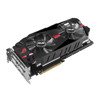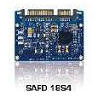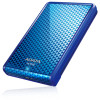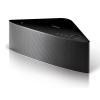![]()

CONTENTS
- Peculiarities of NVIDIA GeForce4 Ti 4200 based video cards from ABIT, Prolink, Palit and Gainward
- Test system configuration, test tools, 2D quality
- New capabilities of anisotropic filtering in 30.* drivers from NVIDIA
- Performance of video cards of the GeForce4 Ti 4200 class
- Conclusion
Today we will take a look at some more NVIDIA GeForce4 Ti 4200 based video cards which are quite popular today. And this time we will focus on new capabilities with the forced anisotropic filtering. Besides, we will describe three more cards based on the NVIDIA's reference design.
As the GeForce4 Ti cards are the final line of the GeForce family, we should turn back to the history. First of all, the GeForce256 and its successor - GeForce2 GTS were single releases. At that time NVIDIA didn't release new lines. When the new products settled down on the market the company came up with their improved versions (GeForce256 DDR, GeForce2 Pro). The GeForce3 went through the same way, though the release of the GeForce3 Ti wasn't planned in advance, it was a response to the ATI RADEON 8500.
By the birth of the NV25 (future GeForce4 Ti) NVIDIA understood that a line was more advantageous than just a single product. And this winter we got two new solutions - Ti4600 and Ti4400. The Ti4200 joined them a bit later. The latter became the most popular among three as it possesses the best price/performance ratio. For overclockers it's a real dream: almost all Ti 4200 based cards easily overclock up to 300 MHz and higher. And the memory overclocking easily reaches Ti 4400. Thus, users get something average between the Ti 4400 and 4600 at a much lower price.
However, all features of the Ti 4200 (and the whole GeForce4 Ti line) were already discussed a lot of times in our reviews of GeForce4 Ti.
Theoretical materials and reviews of video cards which concern functional
properties of the
- NVIDIA GeForce4 Ti review
- MSI GF4Ti4600 on NVIDIA GeForce4 Ti - concerns anisotropic filtering in the 3DMark2001 SE, and new Advanced Pixel Shader Test from this packet.
- Leadtek WinFast GeForce4 Ti 4600 on NVIDIA GeForce4 Ti 4600 - tests based on the Vulpine GLMark with anisotropy enabled.
- Gainward PowerPack GeForce4 Ultra/700XP and Ultra/750XP Golden Sample on NVIDIA GeForce4 Ti 4400/4600 - Codecult Code Creatures and Novalogic Comanche4 Benchmark.
- Chaintech A-GF61 SE on NVIDIA GeForce4 Ti 4600 - dependence of the performance on a CPU speed (AMD Athlon 750, 1000 MHz, Athlon XP 1250, 1666 MHz; in Serious Sam II, Return to Castle Wolfenstein).
- Creative 3D Blaster GeForce4 Ti 4400 on NVIDIA GeForce4 Ti 4400 - dependence of the performance on a CPU speed (Intel Pentium III 1000, Pentium 4 2000, 2200 MHz; in Serious Sam II, Return to Castle Wolfenstein).
- ASUS V8440 and V8460 on NVIDIA GeForce4 Ti 4400 and 4600 - dependence of the performance on a CPU speed (Intel Pentium III 1000, Pentium 4 2000, 2200 MHz, AMD Athlon 750, 1000 MHz, Athlon XP 1250, 1666 MHz; in 3DMark2001 SE).
- ABIT Siluro GF4 Ti on NVIDIA GeForce4 Ti 4400 - AA operation in the 3DMark2001 SE.
- Palit Daytona GeForce4 Ti 4600 - examination of anisotropy on different platforms in 3DMark2001 SE (Game1, Game2).
- Joytech Apollo Bloody Monster II GeForce4 Ti 4600 - examination of anisotropy on different platforms in 3DMark2001 SE (Game3, Game4).
- S/U/M/A/ Platinum GeForce4 Ti 4400 DVI and GeForce4 Ti 4600 SE - examination of anti-aliasing on different platforms in 3DMark2001 SE (Game1, Game2).
- Triplex Millennium Silver GeForce4 Ti 4600 - examination of anti-aliasing on different platforms in 3DMark2001 SE (Game3, Game4).
- Leadtek WinFast A250LE 64MB and Gainward Powerpack Ultra/650XP 128MB on NVIDIA GeForce4 Ti 4200
- S/U/M/A/ Platinum GeForce4 Ti 4200 64MB, 4200SE 64MB and 4200SE 128MB - examination of anisotropy in 3DMark2001 SE, RtCW, Serious Sam: TSE.
- Sparkle GeForce4 Ti 4400 and GeForce4 Ti 4600 cards.
- ABIT Siluro GF4Ti4200, Prolink PixelView GeForce4 Ti 4200, Palit Daytona GeForce4 Ti 4200 128MB and Gainward Powerpack Ultra/650XP 64MB on NVIDIA GeForce4 Ti 4200
S/U/M/A/ Platinum GeForce4 Ti 4200 64MB, GeForce4 Ti 4200 SE 64MB, GeForce4 Ti 4200 SE 128MB - examination of anisotropy in Return to Castle Wolfenstein, Serious Sam: The Second Encounter.
But the main subject today is anisotropic filtering.
Cards
| Albatron GeForce4 Ti 4200 128MB | |
 |
 |
| Sparkle GeForce4 Ti 4200 128MB | |
 |
 |
| Gainward Powerpack Ultra/650 XP 64MB 3.3ns | |
 |
 |
|
|
|
| The card has AGP x2/x4 interface, 128 MB DDR SDRAM located in
8 chips on both PCB sides.
The card comes with Samsung memory of 4ns access time which corresponds to 250 (500) MHz. And the memory runs at this frequency, which is higher than the rated one for 128MB cards - 222 (444) MHz. The GPU works at the frequency typical of Ti 4200 - 250 MHz. |
 |
|
|
|
| The card has AGP x2/x4 interface, 128 MB DDR SDRAM located in
8 chips on both PCB sides.
The card comes with Samsung memory of 4ns access time which corresponds to 250 (500) MHz. But the card operates at 222 (444) MHz which is the rated frequency for such cards. The GPU works at 250 MHz. |
 |
|
|
|
| The card has AGP x2/x4 interface, 64 MB DDR SDRAM located in 8 chips
on both PCB sides.
EtronTech memory has 3.3ns access time which corresponds to 300 (600) MHz; but the memory runs at 256 (513) MHz. The GPU's speed is 250 MHz. |
 |
| Comparison with the reference design, front view | |
| Albatron GeForce4 Ti 4200 128MB | Reference card NVIDIA GeForce4 Ti 4200 |
 |
 |
| Sparkle GeForce4 Ti 4200 128MB | |
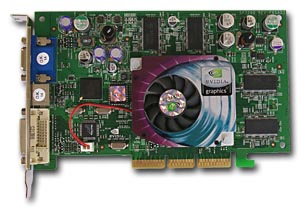 |
|
| Gainward Powerpack Ultra/650 XP 64MB 3.3ns | |
 |
|
| Comparison with the reference design, back view | |
| Albatron GeForce4 Ti 4200 128MB | Reference card NVIDIA GeForce4 Ti 4200 |
 |
 |
| Sparkle GeForce4 Ti 4200 128MB | |
 |
|
| Gainward Powerpack Ultra/650 XP 64MB 3.3ns | |
 |
|
![]()
All the cards follow the reference design, and the Sparkle's solution is a complete copy of the reference card.
Note that starting from a certain time all 64MB cards got a frequency higher by 6 (13) MHz (perhaps since the NVIDIA's release of the new BIOS because all the mentioned cards has the reference BIOS). There is some mess with frequencies. Fortunately, at present they are higher than those recommended by NVIDIA. It concerns the 128MB card from Albatron.
The 64MB and 128MB cards are based on a single design; and the cards differ only in capacity of the memory chips.
Now let's take a peep at each card separately. It's obvious that the cards differ also in a PCB's color and coolers' design.
Here are their coolers:
The cooler hides the GeForce4 Ti 4200 GPU:

In the Gainward's card this codec is used only for TV-out. The Albatron's card has a TV-out based on the Conexant processor.
Now let's take peep inside the boxes:
All video cards ship in retail packages.
That's all about peculiarities of the cards.
Overclocking
| Albatron GeForce4 Ti 4200 128MB | 250/500 -> 310/630 MHz, excellent potential of the card. |
| Sparkle GeForce4 Ti 4200 128MB | 250/444 -> 315/620 MHz, good potential of the core, and the Samsung's memory showed nice results for 4ns. |
| Gainward Powerpack Ultra/650 XP 64MB 3.3ns | 250/513 -> 320/630 MHz, despite 3.3ns the overclocking is not greater as compared with the previous cards. However, the potential is still striking. |
![]()
The scores show that it's easy to reach the level of the Ti 4400, and some come close to the Ti 4600. The chip, by the way, easily outscores 300 MHz.
Note:
- in course of overclocking you must provide additional cooling, in particular, for the card (first of all, for its memory):
- overclocking depends on a definite sample, and you shouldn't generalize the results of one card to all video cards of this mark or series. The overclocking results are not the obligatory characteristics of a video card.

Test system and drivers
Testbeds:- Pentium 4 2200 MHz based computer:
- Intel Pentium 4 2200 (L2=512K);
- ASUS P4T-E (i850) mainboard;
- 512 MB RDRAM PC800;
- Quantum FB AS 20GB;
- Windows XP.
- Athlon XP 1666 MHz (2000+) based computer:
- AMD Athlon XP 2000+
- EPoX 8KHA+ (VIA KT266A);
- 512 MB DDR SDRAM PC2100;
- Fujitsu 20 GB;
- Windows XP.
In the tests we used NVIDIA's drivers of v30.82. VSync was off, S3TC was off.
Test results
Before we start examining 2D quality I should say that there is no a complete technique of objective estimation of this parameter because:- Almost all modern 3D accelerators can have 2D quality much dependent on a certain sample, and it's impossible to trace all cards;
- 2D quality depends not only on a video card, but also on a monitor and a cable;
- Besides, certain monitors do not get along with certain video cards.
| Albatron GeForce4 Ti 4200 128MB | 1600x1200x85Hz, 1280x1024x100Hz, 1024x768x120Hz |
| Sparkle GeForce4 Ti 4200 128MB | 1600x1200x85Hz, 1280x1024x85Hz, 1024x768x100Hz |
| Gainward Powerpack Ultra/650 XP 64MB 3.3ns | 1600x1200x100Hz, 1280x1024x100Hz, 1024x768x120Hz |
![]()
For the performance estimation we used:
- Return to Castle Wolfenstein (MultiPlayer) (id Software/Activision) - OpenGL, multitexturing, Checkpoint-demo, test settings - maximum, S3TC OFF, the configurations can be downloaded from here
- 3DMark2001 SE Pro (MadOnion/Remedy), Game2 "Dragothic"
- DirectX 8.0, Hardware TCL, multitexturing, LOW Details, DXTC OFF, double buffering,24-bit Z-buffer - Serious Sam: The Second Encounter v.1.05 (Croteam/GodGames) - OpenGL, multitexturing, Grand Cathedral demo, test settings: quality, S3TC OFF
- 3DMark2001 Pro (MadOnion/Remedy) -
DirectX 8.0, Hardware TCL, Game1, Game2, Game3, Game4, Low, High detail levels - Comanche4 Benchmark Demo (NovaLogic) - Direct3D, Shaders, Hardware T&L, Dot3, cube texturing, highest quality
- Unreal Tournament 2003 Demo v.927 (Digital Extreme/Epic Games) - Direct3D, Vertex Shaders, Hardware T&L, Dot3, cube texturing, default quality
- RightMark Video Analyzer v.0.4 (Philip Gerasimov) - DirectX 8.1, Dot3, cube texturing, shadow buffers, vertex and pixel shaders (1.1, 1.4).
Test order: enable the console with the '~' button and type:
demo checkpoint (press Enter)
Test order:
using the Batch mode
Test order: enable the console with the '~' button and type:
start up Grand Cathedral demo from the menu
Test order: start up the game the following way:
Test order: run benchmark.bat from folder System of the game changing only
the resolution.
test settings: pixel shaders 1.1, shadow buffers OFF.
New capabilities of anisotropic filtering in 30.* drivers from NVIDIA
As we mentioned a lot of times before this function in the GeForce4 Ti family takes a great deal of resources - the performance falls down by 50-55% when the Level 8 is enabled. Although NVIDIA's anisotropy is more correct and all surfaces are processed irrespective of an angle of inclination, still, a too great speed fall irritates a lot. For details on anisotropy of ATI and NVIDIA see our 3Digest.The software developers of NVIDIA look like an assembly of ancient philosophers who sometimes utter a word of wisdom, but on the whole they are conservative, because we haven't seen yet anisotropy in Direct3D in the drivers' settings (in the OpenGL it's open for users). And if it were not the talented programmer Aleksei Nikolaichuk AKA Unwinder, we would still have to enable anisotropy in Direct3D from the registry, or couldn't do it at all, because some variables are encrypted. I hope that everyone who knows NVIDIA products understand that we mean the RivaTuner utility.
The last version of this program can enable anisotropy and adjust its speed and quality. None of other similar programs is so flexible. But it works only starting from the v30.00 drivers. NVIDIA is probably debugging quick anisotropy in the future NV28/NV18. But it's already available now :-).



Let's estimate with the 3DMark2001 (Game1, Game2, Game4) how reduction of an anisotropy level impacts quality at the texture stages 0 and 1 (the 3DMark2001 works only with two textures in a pass). We set the Level 8, and reduced it to 2 or 4 for each texture stage.
![]()
Let me show you the quality difference in animated GIF files:
| Game 1 | |
| Example 1 | Example 2 |
 |
 |
| Game 2 | |
| Example 1 | Example 2 |
 |
 |
| Game 4 | |
| Example 1 | Example 2 |
 |
 |
![]()
So, what's about the quality?
- In each game decrease of the anisotropy level has a different effect at each stage. In the Game 1 reduction of the anisotropy level hasn't affected the overall quality at the stage 0, contrary to the stage 1 which uses high-detail textures.
- On the whole, reduction of the anisotropy level to 4 at any texture stage affects quality inconsiderably.
Game 1 Low details

The performance levels of the Ti 4200 with the anisotropy levels reduced for each texture stage are almost equal. That is why for the Game1 we recommend Level2 for Stage1.
Game 2 Low details

Game 3 Low details

Game 4

Overall performance
The overclocked cards are marked with red color, sign o/c (overclocked) is followed by the frequencies reached.- 1. Return to Castle Wolfenstein - maximum quality settings
- Windows XP
- Tests on Athlon XP 2000+ (1666 MHz),1024x768
- Tests on Athlon XP 2000+ (1666 MHz),1280x1024
- Tests on Athlon XP 2000+ (1666 MHz),1600x1200
- Tests on Pentium 4 2200 MHz,1024x768
- Tests on Pentium 4 2200 MHz,1280x1024
- Tests on Pentium 4 2200 MHz,1600x1200
- Tests on Pentium III 1000 MHz,1024x768
- Tests on Pentium III 1000 MHz,1280x1024
- Tests on Pentium III 1000 MHz,1600x1200
- 2. Unreal Tournament 2003 DEMO b.927 - standard settings
- Windows XP
- Tests on Athlon XP 2000+ (1666 MHz),1024x768
- Tests on Athlon XP 2000+ (1666 MHz),1280x1024
- Tests on Athlon XP 2000+ (1666 MHz),1600x1200
- Tests on Pentium 4 2200 MHz,1024x768
- Tests on Pentium 4 2200 MHz,1280x1024
- Tests on Pentium 4 2200 MHz,1600x1200
- Tests on Pentium III 1000 MHz,1024x768
- Tests on Pentium III 1000 MHz,1280x1024
- Tests on Pentium III 1000 MHz,1600x1200
- 3. Comanche4 DEMO
- Windows XP
- Tests on Athlon XP 2000+ (1666 MHz),1024x768
- Tests on Athlon XP 2000+ (1666 MHz),1280x1024
- Tests on Athlon XP 2000+ (1666 MHz),1600x1200
- Tests on Pentium 4 2200 MHz,1024x768
- Tests on Pentium 4 2200 MHz,1280x1024
- Tests on Pentium 4 2200 MHz,1600x1200
- Tests on Pentium III 1000 MHz,1024x768
- Tests on Pentium III 1000 MHz,1280x1024
- Tests on Pentium III 1000 MHz,1600x1200
- 5. 3DMark2001, Game2 Low Details (Dragothic)
- Windows XP
- Tests on Athlon XP 2000+ (1666 MHz),1024x768
- Tests on Athlon XP 2000+ (1666 MHz),1280x1024
- Tests on Athlon XP 2000+ (1666 MHz),1600x1200
- Tests on Athlon XP 2000+ (1666 MHz), 800x600, Anti-aliasing
- Tests on Athlon XP 2000+ (1666 MHz), 1024x768, Anti-aliasing
- Tests on Athlon XP 2000+ (1666 MHz), 1280x1024, Anti-aliasing
- Tests on Pentium 4 2200 MHz,1024x768
- Tests on Pentium 4 2200 MHz,1280x1024
- Tests on Pentium 4 2200 MHz,1600x1200
- Tests on Pentium III 1000 MHz,1024x768
- Tests on Pentium III 1000 MHz,1280x1024
- Tests on Pentium III 1000 MHz,1600x1200
- 6. Serious Sam: The Second Encounter
- Windows XP
- Tests on Athlon XP 2000+ (1666 MHz),1024x768
- Tests on Athlon XP 2000+ (1666 MHz),1280x1024
- Tests on Athlon XP 2000+ (1666 MHz),1600x1200
- Tests on Athlon XP 2000+ (1666 MHz), 800x600, Anti-aliasing
- Tests on Athlon XP 2000+ (1666 MHz), 1024x768, Anti-aliasing
- Tests on Athlon XP 2000+ (1666 MHz), 1280x1024, Anti-aliasing
- Tests on Pentium 4 2200 MHz,1024x768
- Tests on Pentium 4 2200 MHz,1280x1024
- Tests on Pentium 4 2200 MHz,1600x1200
- Tests on Pentium III 1000 MHz,1024x768
- Tests on Pentium III 1000 MHz,1280x1024
- Tests on Pentium III 1000 MHz,1600x1200
- 7. 3DMark2001
- 7.1. 3DMark2001 standard tests
- Windows ME
- Tests on Athlon XP 2000+, 1024x768, 3D Marks
- Tests on Athlon XP 2000+, 1024x768, Game1 Low
- Tests on Athlon XP 2000+, 1024x768, Game1 High
- Tests on Athlon XP 2000+, 1024x768, Game2 Low
- Tests on Athlon XP 2000+, 1024x768, Game2 High
- Tests on Athlon XP 2000+, 1024x768, Game3 Low
- Tests on Athlon XP 2000+, 1024x768, Game3 High
- Tests on Athlon XP 2000+, 1024x768, Game4
- Tests on Athlon XP 2000+, 1280x1024, 3D Marks
- Tests on Athlon XP 2000+, 1280x1024, Game1 Low
- Tests on Athlon XP 2000+, 1280x1024, Game1 High
- Tests on Athlon XP 2000+, 1280x1024, Game2 Low
- Tests on Athlon XP 2000+, 1280x1024, Game2 High
- Tests on Athlon XP 2000+, 1280x1024, Game3 Low
- Tests on Athlon XP 2000+, 1280x1024, Game3 High
- Tests on Athlon XP 2000+, 1280x1024, Game4
- Tests on Athlon XP 2000+, 1600x1200, 3D Marks
- Tests on Athlon XP 2000+, 1600x1200, Game1 Low
- Tests on Athlon XP 2000+, 1600x1200, Game1 High
- Tests on Athlon XP 2000+, 1600x1200, Game2 Low
- Tests on Athlon XP 2000+, 1600x1200, Game2 High
- Tests on Athlon XP 2000+, 1600x1200, Game3 Low
- Tests on Athlon XP 2000+, 1600x1200, Game3 High
- Tests on Athlon XP 2000+, 1600x1200, Game4
- Windows XP
- Tests on Pentium 4 2200 MHz, 1024x768, 3D Marks
- Tests on Pentium 4 2200 MHz, 1024x768, Game1 Low
- Tests on Pentium 4 2200 MHz, 1024x768, Game1 High
- Tests on Pentium 4 2200 MHz, 1024x768, Game2 Low
- Tests on Pentium 4 2200 MHz, 1024x768, Game2 High
- Tests on Pentium 4 2200 MHz, 1024x768, Game3 Low
- Tests on Pentium 4 2200 MHz, 1024x768, Game3 High
- Tests on Pentium 4 2200 MHz, 1024x768, Game4
- Tests on Pentium 4 2200 MHz, 1280x1024, 3D Marks
- Tests on Pentium 4 2200 MHz, 1280x1024, Game1 Low
- Tests on Pentium 4 2200 MHz, 1280x1024, Game1 High
- Tests on Pentium 4 2200 MHz, 1280x1024, Game2 Low
- Tests on Pentium 4 2200 MHz, 1280x1024, Game2 High
- Tests on Pentium 4 2200 MHz, 1280x1024, Game3 Low
- Tests on Pentium 4 2200 MHz, 1280x1024, Game3 High
- Tests on Pentium 4 2200 MHz, 1280x1024, Game4
- Tests on Pentium 4 2200 MHz, 1600x1200, 3D Marks
- Tests on Pentium 4 2200 MHz, 1600x1200, Game1 Low
- Tests on Pentium 4 2200 MHz, 1600x1200, Game1 High
- Tests on Pentium 4 2200 MHz, 1600x1200, Game2 Low
- Tests on Pentium 4 2200 MHz, 1600x1200, Game2 High
- Tests on Pentium 4 2200 MHz, 1600x1200, Game3 Low
- Tests on Pentium 4 2200 MHz, 1600x1200, Game3 High
- Tests on Pentium 4 2200 MHz, 1600x1200, Game4
- Comparison of the test results with the Software T&L and with the Hardware T&L
- Windows ME
- Tests on Athlon XP 2000+, 1024x768, Game1 Low
- Tests on Athlon XP 2000+, 1024x768, Game1 High
- Tests on Athlon XP 2000+, 1024x768, Game2 Low
- Tests on Athlon XP 2000+, 1024x768, Game2 High
- Tests on Athlon XP 2000+, 1024x768, Game3 Low
- Tests on Athlon XP 2000+, 1024x768, Game3 High
- Tests on Athlon XP 2000+, 1024x768, Game4
- Tests on Athlon XP 2000+, 1280x1024, Game1 Low
- Tests on Athlon XP 2000+, 1280x1024, Game1 High
- Tests on Athlon XP 2000+, 1280x1024, Game2 Low
- Tests on Athlon XP 2000+, 1280x1024, Game2 High
- Tests on Athlon XP 2000+, 1280x1024, Game3 Low
- Tests on Athlon XP 2000+, 1280x1024, Game3 High
- Tests on Athlon XP 2000+, 1280x1024, Game4
- Tests on Athlon XP 2000+, 1600x1200, Game1 Low
- Tests on Athlon XP 2000+, 1600x1200, Game1 High
- Tests on Athlon XP 2000+, 1600x1200, Game2 Low
- Tests on Athlon XP 2000+, 1600x1200, Game2 High
- Tests on Athlon XP 2000+, 1600x1200, Game3 Low
- Tests on Athlon XP 2000+, 1600x1200, Game3 High
- Tests on Athlon XP 2000+, 1600x1200, Game4
- Windows XP
- Tests on Pentium 4 2200 MHz, 1024x768, Game1 Low
- Tests on Pentium 4 2200 MHz, 1024x768, Game1 High
- Tests on Pentium 4 2200 MHz, 1024x768, Game2 Low
- Tests on Pentium 4 2200 MHz, 1024x768, Game2 High
- Tests on Pentium 4 2200 MHz, 1024x768, Game3 Low
- Tests on Pentium 4 2200 MHz, 1024x768, Game3 High
- Tests on Pentium 4 2200 MHz, 1024x768, Game4
- Tests on Pentium 4 2200 MHz, 1280x1024, Game1 Low
- Tests on Pentium 4 2200 MHz, 1280x1024, Game1 High
- Tests on Pentium 4 2200 MHz, 1280x1024, Game2 Low
- Tests on Pentium 4 2200 MHz, 1280x1024, Game2 High
- Tests on Pentium 4 2200 MHz, 1280x1024, Game3 Low
- Tests on Pentium 4 2200 MHz, 1280x1024, Game3 High
- Tests on Pentium 4 2200 MHz, 1280x1024, Game4
- Tests on Pentium 4 2200 MHz, 1600x1200, Game1 Low
- Tests on Pentium 4 2200 MHz, 1600x1200, Game1 High
- Tests on Pentium 4 2200 MHz, 1600x1200, Game2 Low
- Tests on Pentium 4 2200 MHz, 1600x1200, Game2 High
- Tests on Pentium 4 2200 MHz, 1600x1200, Game3 Low
- Tests on Pentium 4 2200 MHz, 1600x1200, Game3 High
- Tests on Pentium 4 2200 MHz, 1600x1200, Game4
- 8. iXBT RightMark Video Analyzer
Conclusion
The new method of optimization of the anisotropy by decreasing quality of processing of far objects is successful. The performance of the GeForce4 Ti grows up when the anisotropy is active. The quality doesn't get much worse and a user receives a flexible tool of balancing between quality and speed (with anisotropy turned on). Unfortunately, it's available only for those who has the Internet access and can download RivaTuner. The programmers from NVIDIA perhaps consider that this function is meant only for them and for marketers who extol the wonder of anisotropy everywhere, but users who don't have RivaTuner are deprived of it (only half a year ago they finally debugged anisotropy in the control panel in the OpenGL, unlike to the Direct3D).As far as the tested samples are concerned, we have the following things to say:
- The Sparkle video card has an excellent price/speed ratio (VIVO is provided).
- The Albatron's card has an attractive price/speed ratio as well, is based on the reference design and has excellent quality. This card works at increased memory frequencies relative to the rated ones for 128MB cards.
- The new card from Gainward has a good overclocking potential and its overall quality is really high. I just wish the cards had prices comparable to their competitors.
Highs:
- Very good performance in 3D games (up to Ti 4600 when overclocked!);
- Excellent quality of all cards;
- Increased frequencies of some cards; besides, they follow the reference design;
- TV-out in all cards, and VIVO in the Sparkle's model;
- All necessary adapters.
- None.
Write a comment below. No registration needed!


























































